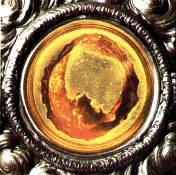One of the reasons I love the Traditional Latin Mass is because the Collect (the beginning prayer to God after the Introit and the Kyrie) usually links heaven and earth. For example, the collect of the votive Mass of St. Joseph reads:
Oh God, who in Thine unspeakable Providence didst vouchsafe to choose blessed Joseph for Thy most holy Mother’s spouse, grant we beseech Thee, that we who revere him as our protector upon earth, may become worthy to have him for our intercessor in heaven.
I have wondered for a few years why the old Mass always ties heaven to earth in the opening prayer. It has to be for more than saccharinely-sweet reasons of saintly piety. It is probably because the prayers of everyone are collected and given to the Blessed Trinity through the sacred humanity of Jesus Christ who is fully God and fully man. God the Son is everywhere on the planet, but only in Catholic and Orthodox tabernacles can we find Jesus of Nazareth in His humanity. The hypostatic union is the ancient teaching that Jesus Christ is one Divine Person subsisting in two natures, human and divine, and so both must be included in the collect.
So, look again at the prayer of St. Joseph above. Heaven and earth do not meet in St. Joseph, but they do meet in Jesus Christ, and St. Joseph participates in this. Thus, we ask Joseph’s protection on earth by being an intercessor in heaven. This collect launches us into the frightful but awesome reality we approach later in the Mass: We are transported outside of time to be at the foot of Calvary where Jesus was murdered. Remember that Jesus is 100% God and 100% man.
Many heretics in the days of the early Church believed that Jesus was God, but doubted that He lived a full experience on earth as man (the heresy of docetism.) Other heretics in the early Church believed that Jesus died but was not God (Arianism—still around.) But the opening collects of the old Mass prevent this way of thinking: By connecting heaven and earth, we begin to see the reality of the hypostatic union in the Eucharistic sacrifice: God dies—not as God—but as a man, and the Mass is this very separation of His body and blood, comprising His death. Later, we receive His resurrected body and blood in every host!
Besides adoration, thanksgiving, reparation and petition, there is something comforting about the hypostatic union that we approach at Mass, beginning at the opening collect. Start with this: Think about your favorite interaction with Jesus and someone in the Gospel. Maybe it’s Mary Magdalene. Maybe it is Peter. Maybe it is the woman whose daughter has a demon. Jesus could look at any person and at that moment, He immediately knew that only He could die for that person because Jesus was the only one more hurt by sin than that individual was. This is because He is God.
But as man, Jesus had His heart pierced. On the Cross, present in the Eucharist, His Divine-human heart was already bursting in pain and sorrow and longing for every human that has ever lived or was living or will live—you and me. He knew outside of time every one of your thoughts, dreams, pains, sins, merits, joys and sufferings. In the offertory of the Mass, we bring our best intentions and our broken hearts. And at the consecration, we on earth are lifted to heaven, but we are not out of place any more: To have our tiny human hearts stretched and broken for the life of the world—this is what it means to console the heart of Jesus Christ.

In suspected Eucharistic miracles, the Eucharistic host in question is brought to secular histologists (experts of human tissue.) What looks like bread, tastes like bread and smells like bread is always found to be cardiac tissue just like the above miracle of Lanciano, revealing still-incorrupt human tissue, even though it started as bread in a doubting priest’s hands over 1000 years ago. This means that the Eucharist is the fullness of Christ, but the Eucharist is especially the physical heart of Jesus of Nazareth whom we receive.
Only Jesus’ heart is fully God and fully man.
